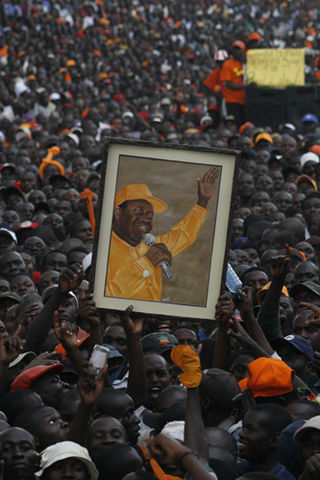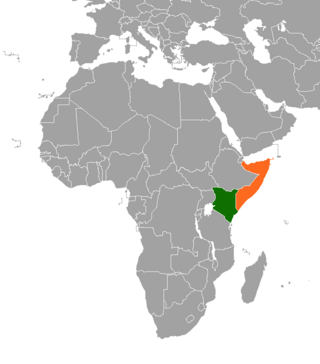
Greater Somalia sometimes called Greater Somaliland is the geographical location comprising the regions in the Horn of Africa in which ethnic Somalis live and have historically inhabited.

The North Eastern Province is one of the former provinces of Kenya. It had a land area of 127,358.5 km2, with its capital at Garissa. The North Eastern Province was carved out of the then Northern Frontier District (NFD) prior to independence.

Garissa is the capital of Garissa County, Kenya. It is situated in the former North Eastern Province.

Garissa County is an administrative county in Kenya. It is located in Eastern Kenya bordering Somalia to the East, Wajir County and Isiolo County to the North, Tana River County to the West and Lamu County to the South. Its capital and largest urban area is Garissa.
Ijara was a former administrative district in the North Eastern Province of Kenya. On May 20, 2000, it was carved out from the larger Garissa District. It covered an area of 11,332 km2 and, according to the population census of 1999, had a population of 62,571. It bordered Garissa District to the north, Lamu District to the south, Tana River District to the west, and Somalia to the northeast. The district had one local authority, Ijara county council, and one constituency, Ijara Constituency. In 2010, it was amalgamated with Garissa County.
Liboi is a town in Garissa County, Kenya, at the border with Somalia.

The timeline of events in the War in Somalia during 2007 is set out below.
The Shifta War or Gaf Daba (1963–1967) was a secessionist conflict in which ethnic Somalis in the Northern Frontier District (NFD) of Kenya attempted to join Somalia. The Kenyan government named the conflict "shifta", after the Swahili word for "bandit", as part of a propaganda effort. The Kenyan counter-insurgency General Service Units forced civilians into "protected villages" as well as killing livestock kept by the pastoralist Somalis.
The Wagalla massacre was a massacre of ethnic Somalis by the Kenyan Army on 10 February 1984 in Wajir County, Kenya. Government troops were ordered to stop clan violence in the area, and did so by first detaining some 5,000 locals at an airstrip, denying them food and water for a week, and then shooting them. The massacre was not investigated by Kenya's government until 2011.
The Boni National Reserve is a national reserve for conservation and lies in the Garissa County, Kenya. The reserve covers an area of 1,339 km2 (517 sq mi) and is managed by Kenya Wildlife Service. It was gazetted in 1976 as a dry season sanctuary for elephants in the former Kenyan Ijara, and Lamu districts and Somalia. The elephant population has been greatly reduced by poaching.

Mohamed Yusuf Haji was a Kenyan politician. He was the Minister of Defence of Kenya from 2008 to 2013, and briefly served as its acting Minister of Internal Security and Provincial Affairs in 2012. He has served in the Senate of Kenya since 2013 under the jubilee party. He died on 15 February 2021.

This is a 2011 timeline of events in the Somali Civil War (2009–present).
From late 2011 to 2014, Kenya experienced an upsurge in violent terrorist attacks. Kenyan government officials asserted that many of the murders and blasts were carried out by al-Shabaab in retaliation for Operation Linda Nchi, a coordinated military mission between the Somalian military and Kenyan military that began in October 2011, when troops from Kenya crossed the border into the conflict zones of southern Somalia. According to Kenyan security experts, the bulk of the attacks were increasingly carried out by radicalized Kenyan youth who were hired for the purpose. Kenya security officials also indicated that they were part of death squads, which carried out many of the killings under the orders of a government security council. By mid-2014, the cumulative attacks began affecting Kenya's tourism industry, as Western nations issued travel warnings to their citizens.

Many terrorist attacks have occurred in Kenya during the 20th and 21st centuries. In 1980, the Jewish-owned Norfolk hotel was attacked by the Palestine Liberation Organization (PLO). In 1998, the US embassy was bombed in Nairobi, as was the Israeli-owned Paradise hotel in 2002 in Mombasa. In 2013, the Somali jihadist group al-Shabaab killed 67 people at Nairobi's Westgate Shopping Mall. There have also been many other attacks.

Ethnic conflicts in Kenya occur frequently, although most are classified as minor skirmishes. A significant increase in the severity of such conflicts between the various ethnic groups inhabiting the country was witnessed after the introduction of multi-party politics in the early 1990s, especially during the 2007–08 Kenyan crisis. Major conflicts have also led to exoduses of ethnic minority communities with roots in other geographical areas.

The Somali–Kenyan conflict has been an issue within Kenya since the colonial period. Problems have ranged from skirmishes between the two communities and have led to terrorist attacks, police harassment, extortion, home invasions, physical violence, and massacres perpetrated against Somalis and Kenyans.
On 2 April 2015, gunmen stormed the Garissa University College in Garissa, Kenya, killing 148 people, and injuring at least 79. The militant groups Al-Qaeda and Al-Shabaab, which the gunmen claimed to belong to, took responsibility for the attack. The gunmen took over 700 students hostage, freeing Muslims and killing those who identified as Christians. The siege ended the same day, when all four of the attackers were killed. Five men were later arrested in connection with the attack, and a bounty was placed for the arrest of a suspected organizer.
On 26 May 2015, Kenyan police were ambushed by Al-Shabaab in Garissa County, which borders with Somalia.

The Battle of El Adde took place on 15 January 2016. Al-Shabaab militants launched an attack on a Kenyan-run AMISOM army base in the town of El Adde, Gedo, Somalia. It remains the deadliest attack on the African Union Mission to Somalia and is the Kenya Defence Forces (KDF) largest defeat since independence in 1963. As such, the Kenyan government went to extreme lengths to conceal the extent of its losses. It has been described by the media as a "military massacre" or military disaster. It was also the largest military defeat in Kenyan history.

This is a 2016 timeline of events in the Somali Civil War (2009–present).












